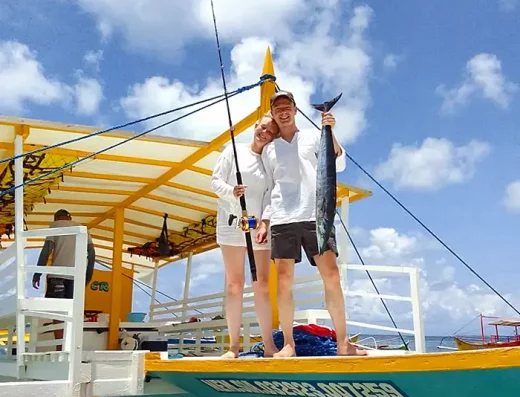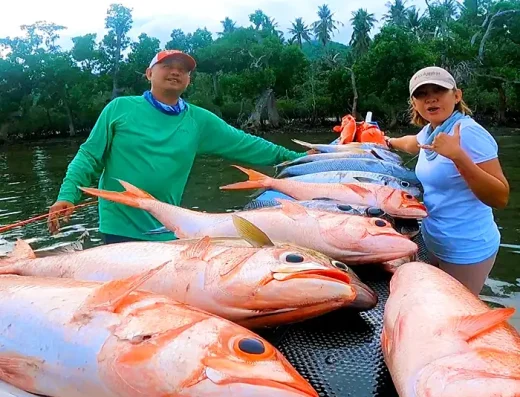Charter Fishing in the Philippines
The Philippines offers fishing across offshore Pacific waters, inshore coral reefs, island channels, and freshwater rivers and lakes.
TrustedFish connects anglers with proven local captains in the Philippines —no commissions, no pay-to-play listings, no BS. Every charter on our platform is invite-only, vetted for skill, local knowledge, and reputation. If they’re listed, they’ve earned it.
Top Rated Charters in the Philippines
Click to View Destinations
The Philippines Fishing Guide
The Philippines’ fisheries are shaped by its archipelagic geography, with over 7,000 islands and one of the longest coastlines in the world. The Pacific side faces deep open water with strong pelagic migrations, while the South China Sea and Sulu Sea offer calmer but equally productive fisheries. The Visayas and Palawan regions have some of the richest reef systems globally, while Mindanao provides both offshore gamefishing and large inland lakes.
Seasonal bite patterns follow monsoon cycles. The dry season (roughly December to May) brings calmer seas and reliable offshore fishing for tuna, marlin, wahoo, and dorado. The wet season (June to November) sees stronger winds but also peak tuna runs in many areas. Inshore, reef species like grouper, snapper, and trevally are consistent year-round, though weather dictates accessibility. Inland waters such as Lake Lanao and Laguna de Bay produce tilapia, carp, catfish, and snakehead throughout the year.
Charter fishing is well developed in hotspots like Siargao, Cebu, Palawan, and Batangas. Offshore trips range from half-day outings targeting wahoo, dorado, or mackerel, to full-day or multi-day big game expeditions for yellowfin tuna and marlin. Boats vary from traditional bangkas (outrigger canoes adapted for fishing) to modern sportfishermen rigged for trolling heavy tackle. Island-hopping liveaboards are also popular, combining reef, inshore, and offshore fishing.
Techniques across the Philippines include trolling lures and rigged baits for pelagics, jigging and popping for trevally and tuna, and bottom fishing for grouper and snapper. Casting plugs, soft plastics, and live bait works well around inshore reefs. Fly fishing is niche but growing, especially for tarpon-like species, trevally, and milkfish. Freshwater anglers rely on bait rigs, spinning tackle, and traditional methods for catfish, tilapia, and carp. The variety of environments requires versatility and adaptation to changing conditions.
Fishing Seasons in the Philippines
Spring
March through May sees calm seas across most coasts, making it one of the best times to fish. Offshore, yellowfin tuna and marlin are active, particularly in eastern waters facing the Pacific. Inshore, reef species feed aggressively as currents stabilize. Freshwater lakes also fish well as water levels drop after the rainy season.
Summer
From June through August, the southwest monsoon brings rougher seas to the west coast, but the Pacific side and southern islands still see strong action. Yellowfin tuna runs peak, and wahoo and dorado are abundant offshore. Inshore trevally and barracuda are aggressive during this period. Inland rivers swell, boosting catfish and carp fishing
Fall
September through November is transitional, with tuna fishing still strong offshore, though weather can be unpredictable. Dorado and wahoo remain reliable. Reef fishing is steady, with grouper and snapper plentiful. Freshwater fishing improves as rains taper, and tilapia and snakehead become more active. Anglers focus on jigging and bottom fishing when offshore conditions are rough.
Winter
December through February is the dry northeast monsoon, bringing calm seas, cooler air, and excellent fishing. Offshore pelagics include marlin, tuna, and sailfish, particularly in eastern and southern waters. Inshore reefs provide consistent snapper, grouper, and trevally action. Freshwater species remain active, with lakes and rivers easier to access in drier weather. Trolling and bottom fishing dominate tactics.
Top Fishing Regions
Siargao (Mindanao)
Known as the “Surfing Capital,” Siargao is also a sportfishing hub, producing sailfish, tuna, and marlin offshore. Inshore waters hold trevally, wahoo, and dorado. Charters range from local bangkas to larger offshore vessels. Fishing is best from March to October.
Cebu & Visayas
The central islands are rich in reef fishing, with grouper, snapper, and trevally abundant. Offshore, tuna, dorado, and wahoo are common. Cebu serves as a charter base with trips extending to nearby islands like Bohol and Negros. The area is reliable year-round
Palawan
Palawan offers some of the Philippines’ most pristine waters. Offshore trips target tuna, marlin, and sailfish, while reefs yield grouper, snapper, and GTs. El Nido and Coron are key launch points, and liveaboards are common. Fishing is productive through most of the year, with calm seas in the dry season.
Batangas (Luzon)
Close to Manila, Batangas is a popular sportfishing spot with tuna, dorado, and marlin offshore, plus reef species inshore. The accessibility makes it a hub for weekend charters. Peak action runs December through May during the dry season.
Mindoro & Verde Island Passage
This region is famous for its biodiversity, with excellent fishing for trevally, grouper, snapper, and pelagics. Offshore trips find tuna and wahoo, while inshore reefs offer steady action. The Passage is fished year-round, with calmer seas in the northeast monsoon.
Lake Lanao (Mindanao)
The largest freshwater lake in the Philippines, Lake Lanao produces tilapia, carp, catfish, and snakehead. Fishing is productive year-round, with bait and spinning tackle widely used. Local guides operate simple boats for visiting anglers.
Top Gamefish in the Philppines
- Yellowfin Tuna – 20 to 200 lb. Found offshore Pacific-facing islands, peak June through October, targeted by trolling, jigging, and live bait.
- Blue Marlin – 150 to 800 lb. Found offshore in deep currents, best December through May, caught by trolling lures and rigged baits
- Sailfish – 40 to 120 lb. Common offshore in the Visayas and Mindanao, best during dry season, targeted by trolling and live bait.
- Wahoo – 10 to 50 lb. Abundant offshore year-round, peaking in summer and fall, caught with high-speed trolling.
- Dorado (Mahi-Mahi) – 10 to 30 lb. Found offshore near weed lines and debris, best in summer, targeted by trolling and casting.
- Giant Trevally (GT) – 10 to 80 lb. Found around reefs and drop-offs nationwide, peak in summer months, targeted with popping, jigging, and live bait.
- Tilapia – 1 to 5 lb. Abundant in freshwater lakes and rivers, caught year-round, targeted with bait rigs and small lures.
- <strongGrouper – 5 to 40 lb. Common along reefs and rocky bottoms, available year-round, caught with cut bait and vertical jigs>Tarpon – 30 to 200 lb. Florida, Gulf Coast; late spring to summer; live bait drifting or sight casting.
The Philippines Fishing FAQs
Do I need a fishing license in the Philippines?
For recreational fishing, no license is required, but charters often operate under local permits. Commercial or large-scale fishing requires government authorization.
What is the best time to fish in the Philippines?
December to May is the most reliable season due to calm seas, but tuna peaks June to October. Freshwater fishing is consistent year-round.
Where are the most popular fishing spots in the Philippines?
Siargao, Cebu, Palawan, Batangas, and Lake Lanao are top destinations, each offering different environments.
How long are typical fishing trips?
Half-day trips target inshore reefs and trevally, while full-day charters head offshore for tuna and marlin. Multi-day liveaboards explore island chains and remote reefs.
What gear should I bring for fishing in the Philippines?
Most charters provide gear, but anglers bring jigs, poppers, and fly rods for GTs and trevally. Offshore requires trolling tackle, while freshwater anglers use light spinning setups.
Are there regulations on keeping fish?
Yes, local size and bag limits apply, though enforcement varies. Billfish and GTs are often released, while reef fish are kept within limits.
Is fishing in the Philippines family-friendly?
Yes, reef and inshore trips for snapper, grouper, and trevally are great for families. Offshore trips for marlin and tuna are more demanding.
Can I fish from shore in the Philippines?
Yes, shore fishing is popular, especially for trevally, barracuda, and snapper around reefs and beaches. Access depends on tides and local rules
How much does a fishing charter cost in the Philippines?
Half-day inshore trips typically cost $150–$300, while full-day offshore charters range $400–$800. Liveaboards and island-hopping expeditions cost more depending on duration.


